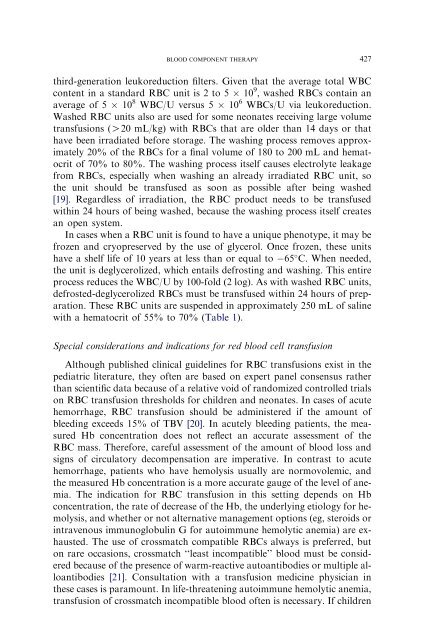Pediatric Clinics of North America - CIPERJ
Pediatric Clinics of North America - CIPERJ
Pediatric Clinics of North America - CIPERJ
Create successful ePaper yourself
Turn your PDF publications into a flip-book with our unique Google optimized e-Paper software.
BLOOD COMPONENT THERAPY<br />
427<br />
third-generation leukoreduction filters. Given that the average total WBC<br />
content in a standard RBC unit is 2 to 5 10 9 , washed RBCs contain an<br />
average <strong>of</strong> 5 10 8 WBC/U versus 5 10 6 WBCs/U via leukoreduction.<br />
Washed RBC units also are used for some neonates receiving large volume<br />
transfusions (O20 mL/kg) with RBCs that are older than 14 days or that<br />
have been irradiated before storage. The washing process removes approximately<br />
20% <strong>of</strong> the RBCs for a final volume <strong>of</strong> 180 to 200 mL and hematocrit<br />
<strong>of</strong> 70% to 80%. The washing process itself causes electrolyte leakage<br />
from RBCs, especially when washing an already irradiated RBC unit, so<br />
the unit should be transfused as soon as possible after being washed<br />
[19]. Regardless <strong>of</strong> irradiation, the RBC product needs to be transfused<br />
within 24 hours <strong>of</strong> being washed, because the washing process itself creates<br />
an open system.<br />
In cases when a RBC unit is found to have a unique phenotype, it may be<br />
frozen and cryopreserved by the use <strong>of</strong> glycerol. Once frozen, these units<br />
have a shelf life <strong>of</strong> 10 years at less than or equal to 65 C. When needed,<br />
the unit is deglycerolized, which entails defrosting and washing. This entire<br />
process reduces the WBC/U by 100-fold (2 log). As with washed RBC units,<br />
defrosted-deglycerolized RBCs must be transfused within 24 hours <strong>of</strong> preparation.<br />
These RBC units are suspended in approximately 250 mL <strong>of</strong> saline<br />
with a hematocrit <strong>of</strong> 55% to 70% (Table 1).<br />
Special considerations and indications for red blood cell transfusion<br />
Although published clinical guidelines for RBC transfusions exist in the<br />
pediatric literature, they <strong>of</strong>ten are based on expert panel consensus rather<br />
than scientific data because <strong>of</strong> a relative void <strong>of</strong> randomized controlled trials<br />
on RBC transfusion thresholds for children and neonates. In cases <strong>of</strong> acute<br />
hemorrhage, RBC transfusion should be administered if the amount <strong>of</strong><br />
bleeding exceeds 15% <strong>of</strong> TBV [20]. In acutely bleeding patients, the measured<br />
Hb concentration does not reflect an accurate assessment <strong>of</strong> the<br />
RBC mass. Therefore, careful assessment <strong>of</strong> the amount <strong>of</strong> blood loss and<br />
signs <strong>of</strong> circulatory decompensation are imperative. In contrast to acute<br />
hemorrhage, patients who have hemolysis usually are normovolemic, and<br />
the measured Hb concentration is a more accurate gauge <strong>of</strong> the level <strong>of</strong> anemia.<br />
The indication for RBC transfusion in this setting depends on Hb<br />
concentration, the rate <strong>of</strong> decrease <strong>of</strong> the Hb, the underlying etiology for hemolysis,<br />
and whether or not alternative management options (eg, steroids or<br />
intravenous immunoglobulin G for autoimmune hemolytic anemia) are exhausted.<br />
The use <strong>of</strong> crossmatch compatible RBCs always is preferred, but<br />
on rare occasions, crossmatch ‘‘least incompatible’’ blood must be considered<br />
because <strong>of</strong> the presence <strong>of</strong> warm-reactive autoantibodies or multiple alloantibodies<br />
[21]. Consultation with a transfusion medicine physician in<br />
these cases is paramount. In life-threatening autoimmune hemolytic anemia,<br />
transfusion <strong>of</strong> crossmatch incompatible blood <strong>of</strong>ten is necessary. If children





